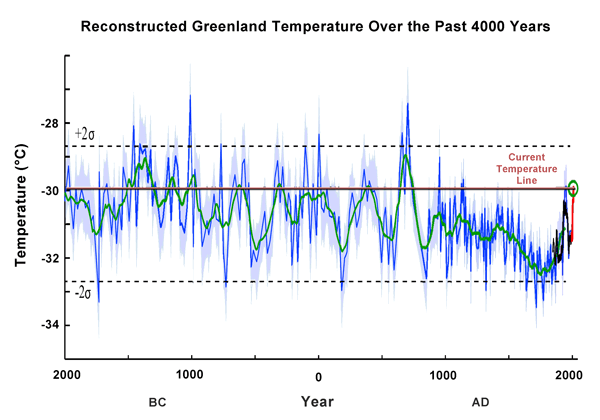Reference
Kobashi, T., Kawamura, K., Severinghaus, J.P., Barnola, J.-M., Nakaegawa, T., Vinther, B.M., Johnsen, S.J. and Box, J.E. 2011. High variability of Greenland surface temperature over the past 4000 years estimated from trapped air in an ice core. Geophysical Research Letters 38: 10.1029/2011GL049444.
Background
The authors write that, supposedly, "Greenland recently incurred record high temperatures and ice loss by melting, adding to concerns that anthropogenic warming is impacting the Greenland ice sheet and in turn accelerating global sea-level rise." However, they state that "it remains imprecisely known for Greenland how much warming is caused by increasing atmospheric greenhouse gases versus natural variability."
What was done
In rigorously exploring this question of recent warmth attribution, Kobashi et al. reconstructed "Greenland surface snow temperature variability over the past 4000 years at the GISP2 site (near the Summit of the Greenland ice sheet; hereafter referred to as Greenland temperature) with a new method that utilizes argon and nitrogen isotopic ratios from occluded air bubbles," as described in detail by Kobashi et al. (2008a,b).
What was learned
The eight researchers report that "the temperature record starts with a colder period in 'the Bronze Age Cold Epoch'," which they say was followed by "a warm period in 'the Bronze Age Optimum'," which was followed by a 1000-year cooling that began "during 'the Iron/Roman Age Optimum'," which was followed by "the Dark Ages," which was followed by "the Medieval Warm Period," which was followed by "the Little Ice Age" - which they describe as "the coldest period of the past 4000 years" - which was followed, last of all, by "the recent warming." For comparative purposes, they also note that "the current decadal average surface temperature at the summit is as warm as in the 1930s-1940s, and there was another similarly warm period in the 1140s (Medieval Warm Period)," indicating that "the present decade is not outside the envelope of variability of the last 1000 years." In fact, they say that "excluding the last millennium," there were fully "72 decades warmer than the present one, in which mean temperatures were 1.0 to 1.5°C warmer," and that during two centennial intervals, average temperatures "were nearly 1.0°C warmer than the present decade" (see the authors Figure 1, adapted below).

Reconstructed Greenland snow surface temperatures for the past 4000 years as adapted from Figure 1 of Kobashi et al. (2011). The blue line and blue band represent the reconstructed Greenland temperature and 1σ error, respectively. The green line represents a 100-year moving average of the blue line. The black and red lines indicate the Summit and AWS decadal average temperatures, respectively, as calculated by others.
What it means
Since the Greenland summit's decadal warmth of the first ten years of the 21st century was exceeded fully six dozen times over the prior four millennia, it is clear that it was in no way unusual, unnatural or unprecedented; and, therefore, it is clear that none of Greenland's recent warming need have been caused by increasing greenhouse gases. Indeed, it is far more likely that its recent warmth is nothing more than the next expected phase of the natural oscillation of climate that has produced several-hundred-year periods of alternating warmth and cold over the past four thousand years. See Climate Oscillations (Millennia Variability) in our Subject Index for more on this important topic.
References
Kobashi, T., Severinghaus, J.P. and Kawamura, K. 2008a. Argon and nitrogen isotopes of trapped air in the GISP2 ice core during the Holocene epoch (0-11,600 B.P.): Methodology and implications for gas loss processes. Geochimica et Cosmochimica Acta 72: 4675-4686.
Kobashi,, T., Severinghaus, J.P. and Barnola, J.-M. 2008b. 4 ± 1.5°C abrupt warming 11,270 yr ago identified from trapped air in Greenland ice. Earth and Planetary Science Letters 268: 397-407.
Reviewed 15 February 2012



